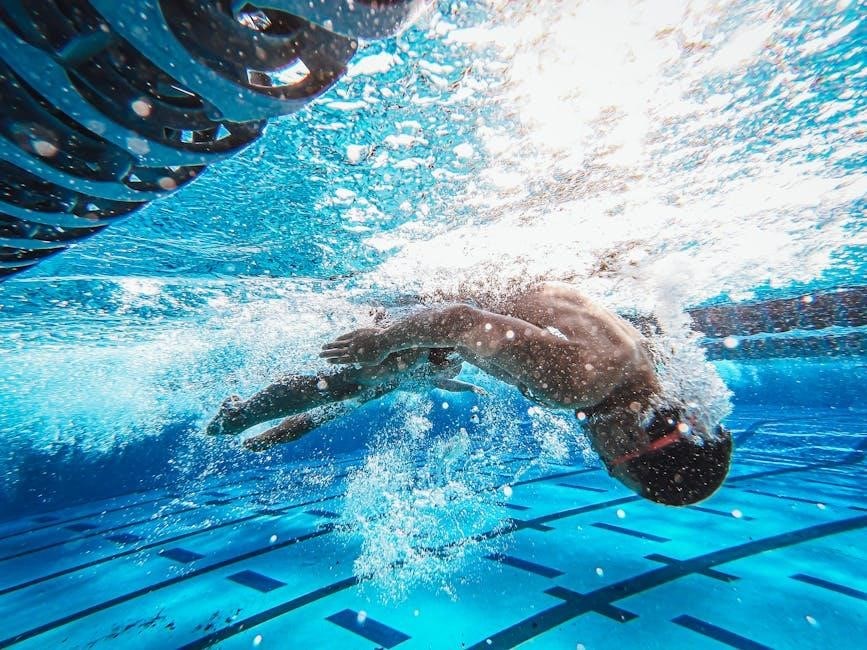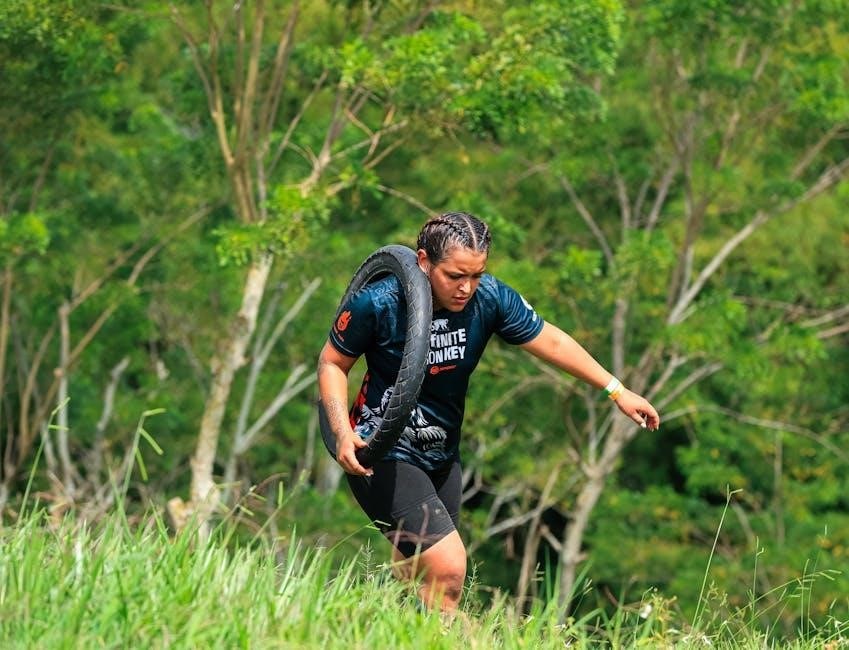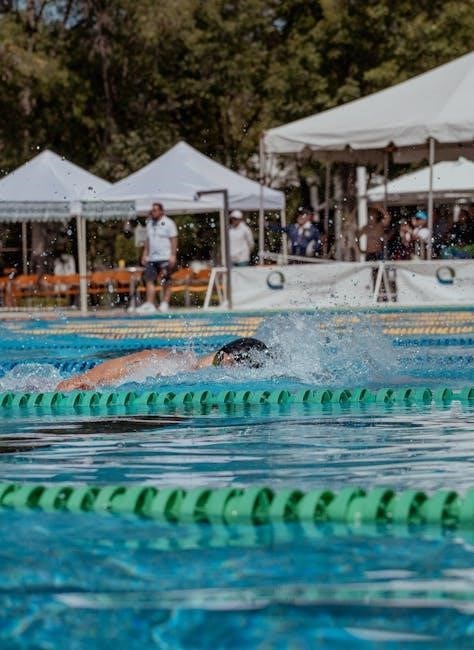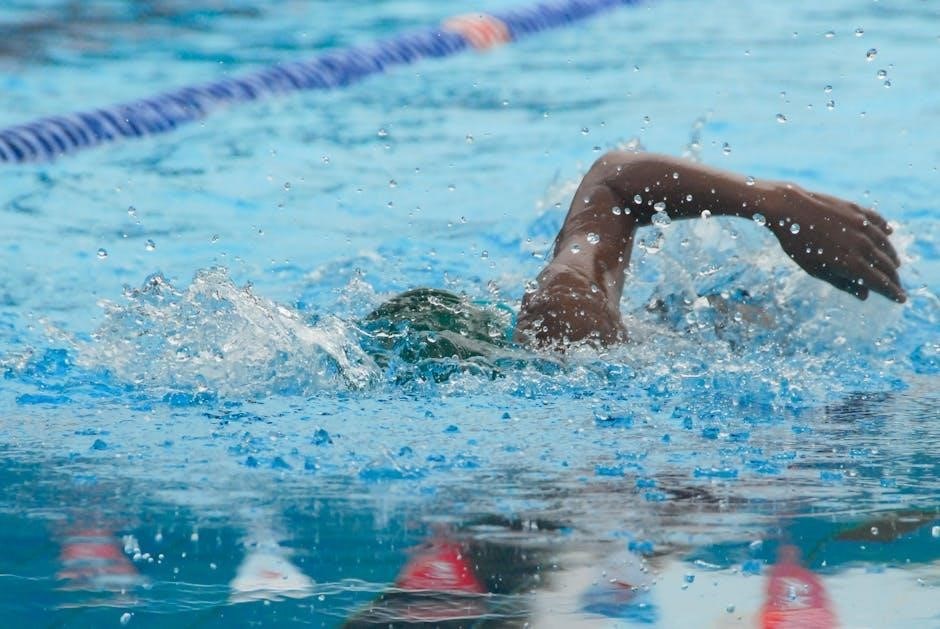The Spartan Race Training Plan PDF offers a comprehensive guide for participants of all levels. It includes structured workouts, expert tips, and nutrition advice to ensure success.
Overview of the Spartan Race
The Spartan Race is a series of obstacle course races designed to test strength, endurance, and mental toughness. Inspired by ancient Spartan warriors, it challenges participants with varying distances and obstacles. The races range from the Sprint (5K with 20 obstacles) to the Beast (21K with 30 obstacles), pushing athletes to their limits. Each race demands physical and mental resilience, embodying the Spartan ethos of perseverance and determination.
Importance of a Structured Training Plan
A structured training plan is essential for Spartan Race success. It ensures progressive overload, injury prevention, and skill development. By following a tailored program, participants build strength, endurance, and obstacle-specific skills systematically. This approach maximizes efficiency, helping athletes adapt to race demands and overcome challenges confidently. A well-organized plan also enhances mental toughness, crucial for tackling tough courses and obstacles, ensuring readiness for race day.
Key Components of the Training Plan
The Spartan Race Training Plan PDF includes strength and endurance building, obstacle-specific drills, and cardiovascular exercises. It incorporates tempo runs, interval training, and hill workouts to enhance stamina. The plan also emphasizes functional fitness, bodyweight exercises, and weighted resistance. Additionally, it covers nutrition strategies, recovery techniques, and mental preparation. This holistic approach ensures athletes are physically and mentally prepared for the challenges of the Spartan Race, fostering confidence and resilience.

Understanding the Spartan Race
The Spartan Race is a premier obstacle course racing event, offering Sprint, Super, and Beast distances. It demands physical and mental toughness, embodying the Spartan spirit.
Types of Spartan Races (Sprint, Super, Beast)
The Spartan Race offers three main categories: Sprint (5K, 20-25 obstacles), Super (10K, 25-30 obstacles), and Beast (21K, 30-35 obstacles). Each race type increases in difficulty, requiring greater endurance, strength, and mental resilience. The Sprint is ideal for beginners, while the Beast challenges experienced athletes. These races test physical and mental limits, ensuring a transformative experience for all participants.
Common Obstacles and Challenges
Spartan Races feature obstacles like walls, rope climbs, sandbags, and barbed wire crawls. Participants face physical challenges such as heavy carries, uneven terrain, and mental tests like fear of heights. These obstacles demand strength, agility, and endurance, pushing racers to their limits. The races are designed to test overall resilience, ensuring a challenging and transformative experience for all participants.
Physical and Mental Demands
Spartan Races demand exceptional physical fitness, including strength, endurance, and cardiovascular health. Participants must overcome obstacles requiring muscular power and agility. Mentally, racers need resilience, focus, and the ability to push through discomfort. The races test both physical and mental limits, ensuring a challenging experience that builds confidence and determination. Proper training is essential to meet these demands and excel in the event.

Key Components of the Training Plan
The plan includes structured workouts, progressive overload, and periodization. It balances strength, endurance, and obstacle-specific training, ensuring a well-rounded approach to prepare for race day challenges.

Building Strength and Endurance
Building strength and endurance is crucial for Spartan Race success. The plan incorporates progressive overload, functional exercises like squats and lunges, and sandbag training to enhance muscular endurance. Periodization ensures balanced progression, avoiding plateaus. Consistency in these workouts prepares athletes for the race’s physical demands, fostering resilience and power needed to tackle obstacles and long-distance runs effectively.
Incorporating Obstacle-Specific Training
Incorporating obstacle-specific training is essential for Spartan Race preparation. This includes exercises like rope climbs, wall traverses, and sandbag carries, which mimic race challenges. Using tools like weighted resistance and bodyweight progressions builds functional strength. Practicing techniques for obstacles such as spear throws and barbed wire crawls enhances efficiency and confidence. This targeted approach ensures athletes are well-prepared to tackle the course’s physical and mental demands effectively.
Cardiovascular and Functional Fitness
Cardiovascular and functional fitness are critical for Spartan Race success. Tempo runs and interval training improve heart rate endurance, while hill workouts build leg strength and stamina. Functional exercises like burpees and jump squats enhance agility and coordination. These workouts simulate race conditions, ensuring participants can handle the course’s physical demands. Consistent cardiovascular training boosts overall endurance, enabling athletes to maintain energy levels throughout the race and overcome obstacles with confidence.

Running and Cardiovascular Training
Running and cardiovascular training are essential for building endurance and stamina. Tempo runs, interval training, and hill workouts prepare athletes for the race’s physical demands and improve overall fitness.
Tempo Runs and Threshold Training
Tempo runs involve maintaining a steady, challenging pace to enhance endurance and speed. Threshold training targets the anaerobic threshold, improving the body’s ability to handle high-intensity efforts. Both methods are crucial for building cardiovascular fitness and mental resilience, preparing participants for the demanding nature of Spartan races. Incorporating these workouts into a training plan ensures athletes can sustain effort over long distances and recover efficiently between obstacles.
Interval and Fartlek Training
Interval training involves alternating between high-intensity bursts and recovery periods, enhancing cardiovascular fitness and speed. Fartlek training uses random intervals of high intensity for a dynamic workout. Both methods improve endurance, agility, and mental toughness, preparing athletes for the unpredictable demands of Spartan races. These workouts are essential for building stamina and adaptability, ensuring participants can tackle obstacles and varied terrain with confidence and efficiency during the race.
Hill Workouts for Race Preparation
Hill workouts are crucial for building strength and endurance, essential for tackling the steep inclines common in Spartan races. Incorporate weekly hill sprints and long climbs to enhance power and stamina. These exercises target the legs, core, and cardiovascular system, preparing you for the rigorous terrain. Consistent hill training ensures you can conquer challenging elevations with confidence, making you more competitive on race day.

Obstacle-Specific Training
Obstacle-specific training is essential for building the skills and strength needed to conquer Spartan Race challenges. It involves bodyweight exercises, sandbag work, and mastering obstacle techniques to improve efficiency and reduce injury risk.
Bodyweight Exercises and Progressions
Bodyweight exercises are a cornerstone of Spartan Race training, building strength and endurance without equipment. Progressions like push-ups, squats, and lunges target key muscle groups. Start with basic movements and gradually increase difficulty by adding reps, depth, or pauses. Incorporating variations, such as single-leg squats or plyometric push-ups, enhances power and stability. These exercises prepare racers for obstacle-specific challenges, ensuring a strong foundation for more advanced training and real-world race demands.
Using Sandbags and Weighted Resistance
Sandbags and weighted resistance are essential for building functional strength. A 15-pound sandbag is often used in training plans to simulate race obstacles. Exercises like squats, lunges, and presses with sandbags enhance endurance and power. This resistance training mimics the challenges of carrying heavy objects during the race, preparing racers for real-world demands. Incorporating sandbags into workouts ensures a strong, race-ready physique.
Practicing Obstacle Techniques
Mastering obstacle techniques is crucial for Spartan Race success. Start with fundamental movements like wall climbs, rope ascents, and barrier navigation. Progress to more complex challenges, such as weighted carries and balance beams. Practice mimics real race obstacles, ensuring confidence and efficiency. Incorporate obstacle-specific drills into workouts to build agility and strength, preparing for the unpredictable terrain and demands of race day.
Nutrition and Recovery
Nutrition and recovery are foundational to Spartan Race success. Focus on balanced meals, proper hydration, and post-workout recovery strategies to optimize performance and support muscle repair.
Fueling for Performance
A well-balanced diet is crucial for Spartan Race success. Focus on lean proteins, complex carbs, and healthy fats to fuel workouts and aid recovery. Hydration is key, with electrolytes replenishing lost salts. Timing meals around training ensures optimal energy levels. Avoid processed foods and opt for whole, nutrient-dense options to support endurance and strength. Proper nutrition enhances performance, accelerates recovery, and prepares the body for race-day demands.
Post-Workout Recovery Strategies
Proper recovery is essential for optimal performance. Rehydrate with electrolyte-rich fluids to replenish lost salts. Incorporate stretching and foam rolling to reduce muscle tension. Prioritize sleep, aiming for 7-9 hours nightly, to aid muscle repair. Consider post-workout nutrition, such as a protein and carb-rich meal, within 30 minutes of training. Active recovery, like light walks or yoga, can also enhance healing. Consistent recovery practices ensure your body is ready for the next challenge.
Hydration and Electrolyte Balance
Hydration and electrolyte balance are crucial for peak performance and recovery. Aim to drink 8-10 glasses of water daily, increasing intake during intense workouts. Electrolytes like sodium, potassium, and magnesium help regulate fluid balance and prevent cramps. Use sports drinks or electrolyte tablets during long sessions to replenish lost salts. Monitor urine color for hydration levels—pale yellow indicates proper hydration. Neglecting electrolyte balance can lead to fatigue and poor performance, so prioritize it in your training routine.
Mental Preparation and Toughness
Mental strength is key to conquering the Spartan Race. Develop resilience through positive self-talk, goal setting, and visualization. A strong mindset will help overcome obstacles and push through challenges.
Building Confidence and Resilience
Building confidence and resilience is crucial for Spartan Race success. Start with achievable goals, celebrate progress, and embrace challenges as growth opportunities. Consistent training and positive self-talk foster mental toughness. Visualization techniques and focusing on past successes reinforce self-belief. Resilience develops through overcoming setbacks, allowing racers to stay motivated and composed under pressure. A strong mindset transforms obstacles into stepping stones for victory.
Visualization Techniques
Visualization techniques are powerful tools to mentally prepare for the Spartan Race. By vividly imagining the course, obstacles, and race-day scenarios, participants build mental clarity and focus. Regular visualization helps reduce race-day anxiety and boosts confidence. Athletes can mentally rehearse overcoming challenges, reinforcing resilience and determination. This practice strengthens the connection between mind and body, ensuring a stronger, more focused performance when facing real obstacles on the course.
Overcoming Fear and Anxiety
Overcoming fear and anxiety is crucial for Spartan Race success. Break the race into manageable parts, focusing on one obstacle at a time. Positive self-talk and mindfulness can help calm nerves. Gradual exposure to challenging situations during training builds confidence. Emphasize what you can control, like preparation and effort, rather than outcomes. Remind yourself of past successes to reinforce mental strength. Fear is natural, but with the right mindset, it can fuel determination and drive.

Sample Training Plans
Discover structured plans like the 5-week Couch-to-Sprint, 6-week Strength and Endurance, and 12-week Comprehensive Program. These plans progressively build fitness for race day success.

5-Week Couch-to-Sprint Plan
This plan is designed for beginners, transitioning from walking to jogging and incorporating bodyweight exercises. It progresses gradually, introducing sandbag resistance in later weeks. The focus is on building endurance and strength, ensuring participants are race-ready. Each week includes specific workouts, such as tempo runs and obstacle simulations, to prepare for the challenges of the Spartan Sprint. The plan is straightforward, with no unnecessary elements, ensuring a solid foundation for first-time racers.
6-Week Strength and Endurance Plan
This 6-week plan focuses on building strength, endurance, and mental toughness. It includes hill workouts, interval training, and obstacle-specific exercises. Participants progress through structured phases, combining cardio with functional fitness. The plan ensures race readiness by enhancing physical and mental capabilities, preparing athletes for the demands of the Spartan Race. It’s designed to be challenging yet achievable, helping participants build confidence and resilience for the start line.
12-Week Comprehensive Training Program
This 12-week program is designed to build strength, endurance, and mental toughness for the Spartan Race. It includes phased progression, combining functional fitness, obstacle-specific training, and cardio. The plan is structured to enhance physical and mental capabilities, ensuring participants are race-ready. Suitable for all levels, it focuses on building confidence and resilience through a balanced approach to training, preparing athletes for the challenges of the Spartan Race.
Final Tips for Race Day
Ensure proper gear, stay hydrated, and maintain a steady pace. Visualize success, stay focused, and trust your training. Mental toughness will drive you to the finish.

Equipment and Gear Checklist
Ensure you have proper footwear, moisture-wicking clothing, and durable gloves. Carry a water bottle or hydration pack, headlamp for early starts, and a small first aid kit. Wear a race belt for bib attachment and consider lightweight, breathable gear. Avoid cotton to prevent chafing. Pack extra socks and clothing for post-race. Double-check all items to avoid race-day setbacks and ensure you’re fully prepared to tackle the course confidently.
Race Strategy and Pacing
Start with a sustainable pace, avoiding early exhaustion. Use threshold training to set intensity benchmarks. Incorporate interval runs to build endurance and adaptability. Include hill workouts to strengthen legs and improve climbing efficiency. Practice race-specific strategies, like obstacle approaches and transitions. Adapt your pacing based on course terrain and demands. Stay consistent, listen to your body, and maintain mental focus to ensure a strong finish. Proper pacing is key to overcoming challenges and achieving your race goals effectively.
Mental Preparation for the Start Line
Mental preparation is crucial for tackling the Spartan Race. Use visualization techniques to imagine overcoming obstacles and crossing the finish line. Practice positive affirmations to build confidence and resilience. Focus on breathing exercises to stay calm under pressure. Develop a pre-race routine to mentally prepare and reduce anxiety. Embrace challenges as opportunities to grow, and remind yourself of your training and capabilities. A strong mindset will help you stay focused and determined from start to finish.
Conclusion

The Spartan Race Training Plan PDF provides a comprehensive guide to preparing for the race. It offers structured workouts, nutrition advice, and mental strategies to help you succeed and push your limits for future challenges.
Summarizing the Training Plan
The Spartan Race Training Plan PDF outlines a structured approach to preparing for the race, focusing on building strength, endurance, and mental toughness. It incorporates obstacle-specific training, cardiovascular exercises, and nutrition advice. The plan offers various programs, such as a 5-week Couch-to-Sprint plan and a 12-week comprehensive program, catering to different fitness levels. By balancing physical and mental preparation, the plan ensures participants are well-equipped to tackle the challenges of the Spartan Race with confidence and determination.
Encouragement for First-Time Participants
Embrace the challenge and believe in your potential! The Spartan Race Training Plan is designed for everyone, whether you’re starting from the couch or transitioning from another sport. Stay committed, and you’ll build the confidence and resilience needed to conquer the course. Celebrate small victories, stay consistent, and trust the process. Remember, every obstacle is an opportunity to grow stronger—physically and mentally. You’ve got this!
Continuous Improvement and Future Races
Completing a Spartan Race is just the beginning! Use the training plan as a foundation to continuously improve and tackle future races with confidence. Each race is a learning opportunity to refine your skills and build resilience. Set new goals, embrace challenges, and keep pushing your limits. The journey to becoming a Spartan is lifelong—stay committed, and you’ll be ready for whatever comes next. The path to greatness is endless!
